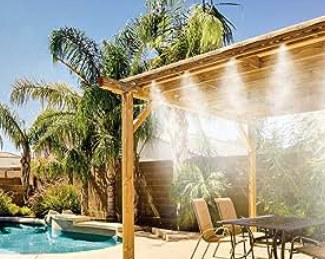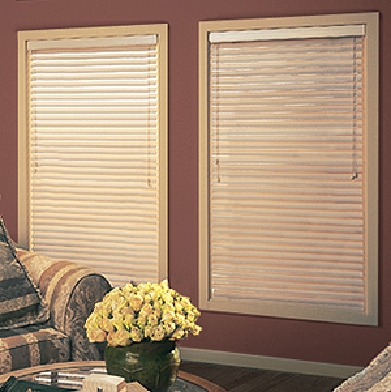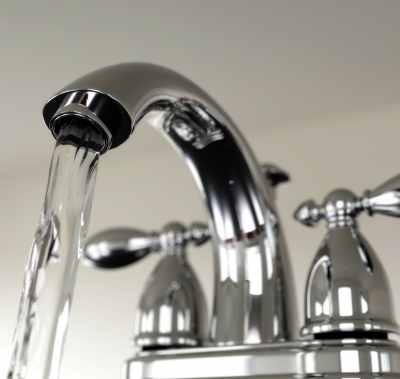When the Temperature soars, it saps your energy and makes life miserable. So, how do you keep your house cool (without cranking up the A/C and driving your electric bill through the roof)? As a former Solar installer and Energy consultant, I learned a few secrets that I’ll gladly share to help make your summers less miserable.
Shade, Shade and More Shade
Shade can be your best friend when trying to reduce the effects of the hot summer sun. Just stopping the Sun from beating down on you can make things feel several degrees cooler. In addition to creating shade, trees create a cooling effect through a process called transpiration. As their leaves emit water that water evaporates and creates a cooling effect. Experts have studied the process and estimate that the average tree reduces the surrounding area by from 7° to 15° C (or 12° to 27°F). So, just being near a tree can feel 20° cooler.
Unfortunately, trees take a long time to grow. So, although it is a good idea to plant some trees near your house (but not too near), they aren’t going to help immediately.
So, what can you do to create some shade now?
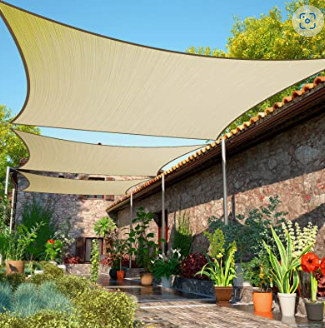
The easiest thing is to put up a “Shade Sail”. They come in all shapes and sizes and range in price from about $30 and up. They are heavy duty and can withstand the sun, wind and weather if properly attached. Although, it is probably a good idea to take them down if a hurricane is coming.
You can check out a variety of them on Amazon. I put one in front of my house to help reduce the hot Florida sun and it made a big difference. I got a triangular one because my house and garage make an “L-shape”. So, I was able to attach it under the eaves on three corners and I didn’t have to put a pole in for the 4th corner. Although, it would have created much more shade with that 4th corner.
The one I got isn’t waterproof, which has its advantages and disadvantages. The advantage is that water doesn’t pool in the center (it just slowly drips through). Of course, the disadvantage is that you can’t expect it to protect you from getting wet when it is raining. Although it drastically reduces the amount of water that hits you.
Note: Shading your heat pump’s outside condenser can help reduce the amount of energy it consumes, since it doesn’t have to work as hard. Just don’t block any airflow.
Water, Water, Cooling Water
In addition to shade, water is your next best friend in the heat. I’m not talking about a nice cool drink (although that is nice too) but rather the effects that water can have in cooling. We’ve already seen the cooling effect that trees can have by allowing moisture to evaporate from their leaves. This is based on a scientific principle brilliantly named “Evaporative Cooling”. Everyone who has ever sweat knows that sweat evaporates to cool their body and a little breeze helps that evaporative process.
The reason this works is that during evaporation the only molecules that escape are the higher energy ones (that are moving fast enough). So that leaves behind the slower moving (i.e., cooler) molecules. Also, anytime an element changes phase i.e., from liquid to gas it uses energy (i.e., reduces heat). Some very dry climates like Arizona use this principle in devices called “Swamp Coolers” to help keep their houses cool without using A/C.
We can use this principle to our advantage in other ways. There are very inexpensive things like misters that spray a light mist into the air creating a cool cloud. If working properly this mist evaporates almost immediately sucking heat energy with it… without actually getting anything wet.
Evaporate Don’t Soak
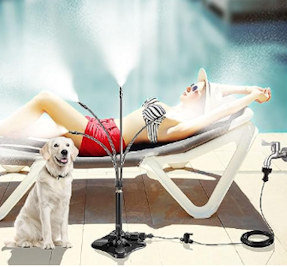
The key is to mount the misters high enough so that they have time to evaporate before the water actually hits anything. These are often used in outdoor cafés. And although they generally use expensive systems that have timers, thermostats, and pumps, you can get a smaller system that connects to a garden hose and a filter for under $50 from Amazon. There are also personal misters. And Misters that can be attached to a fan.
Many years ago, I used this principle in a unique way. I lived up in the mountains in Virginia. And being on top of the mountain, we got a lot of sun in the summer and our water well wasn’t deep enough to produce an excess of water. So, we did what most people do when water is scarce… we collected rainwater. Our garage had a metal roof (which helped reflect some of the heat) but it was still hot. (Imagine a metal slide in the summer).
As I said, we collected rainwater off that metal roof into a huge 1000-gallon cistern. In an effort to keep the garage roof cool, I ran a 1/2″ black plastic pipe along the ridge of the roof and poked holes along it about 18” apart. And I connected it to the pump on the cistern. So, although it didn’t create a mist, it did create a small flow of water down the roof. And since we were collecting the water at the bottom anyway, it wasn’t wasting any water… since it would just end up back in the cistern. And the pump used much less electricity than an A/C unit would. So, although there wasn’t much “mist” the cool water running on the roof did keep it much cooler and with less evaporative water loss.
If your roof is not shaded, you could easily run one of those $30 mister lines along the ridge of your roof. This can drastically reduce your cooling bill. And there are misters available that can be attached to your A/C outside unit that only turn on when the outside fan kicks on.
Reduce Reflected Heat
This one actually surprised me. When I moved to Florida my house had the ugliest orange (my wife called it “Terracotta”) colored driveway. It was a fairly dark color. And I couldn’t stand it. So, after a lot of work cleaning it up, I got it repainted a nice light blue. And that Summer, I got a terrible surprise. When the sun was in the West (i.e., all afternoon in the hottest part of the day) the Sun would reflect off the light-colored driveway and hit the front of the house, which made it 10 degrees hotter in the house! I couldn’t believe it.
So, I got some “Granite Grip” rubberized driveway paint from Home Depot and repainted it a darker blue and that made a world of difference. The combination of texture and darker color helped eliminate the reflected heat and the rubberized nature of the driveway made it cooler to walk on. I will have to say that it took a lot of paint to cover the driveway because you have to put it on relatively thick to get it to look good. But it was worth it!
The moral of this story is that light colors… whether it be rocks or a driveway, can reflect heat into your house, so just beware of that fact!
Attic Fans
As you probably know attics can get VERY hot. The roof is generally not insulated but rather the ceiling of the living space is insulated (which is the floor of the attic). So, the sun beats down on the (often dark colored) roof and the heat radiates down into the attic often making it 120° – 130° degrees F up there. And then that heat works its way through the insulation… making your house hotter.
So, if you can replace that 130° air with cooler air your house will stay cooler. And just sucking the heat out (if possible) uses much less electricity than trying to cool it down.
Personally, I’ve had mixed results with attic fans. When I was a kid living in an unairconditioned house on Long Island in New York. We installed an attic fan that created a cross ventilation in the attic. And with the outside air at 90° we could suck that 120° air out and replace it with 90° air and it did a great job of making the house cooler.
When I moved to Virginia, I installed attic fans in both my house and my daughter’s house and both of them helped a great deal. But they do use some electricity to run, so when I moved to Florida, I decided to install a Solar Powered Attic Fan. Rather than mounting these in the side gables and using a thermostat to decide when to turn on and off, it installs in a hole in the roof and uses the Sun to create electricity. And although it works, I’ve heard that the benefit isn’t that great in really hot places like Florida and Texas because instead of sucking in 90° air you are sucking in 110° air, so it isn’t all that much cooler.
I also think that you need to be sure that you have good cross-ventilation, mounting a fan in the roof (rather than the gable) might only suck air in through the ridge vents rather than pulling it all the way across the attic. So, you need to be aware of what the air flow will look like.
Attic Insulation
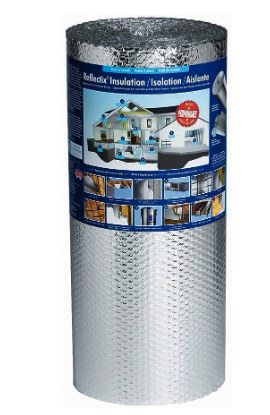
As I said previously, the roof of the attic is generally not insulated and that is for a good reason. You have to be careful about moisture buildup under the wood decking. But once again, I came up with a solution that not only insulated the roof but still allowed for air circulation between the rafters.
I bought several rolls of Reflectix insulation which is basically shiny foil like bubble wrap. I then stapled it to the bottom of the rafters leaving about a foot of space at both the bottom and the top of the roof. This created an air channel “chimney” that allowed air to circulate upward toward the ridge vent but not enter the attic too much. The reflective surface also prevented radiant energy from getting any further than the top side of the reflectix.
To conquer the heat, we have to remember our High School Physics. Heat energy travels in three ways, Conduction, Convection and Radiation. The reflective surface fights the radiation portion. The bubbles slow the conduction, and the air channel helps convection to carry the heat upward toward the ridge vent rather than circulating in the attic.
Another thing I have done is, whenever I got any large pieces of cardboard I would throw then on the floor of the attic (which really wasn’t a floor at all, only beams with insulation between them). This had several advantages. First, the air spaces in the cardboard actually make it fairly good insulation. Secondly, it eliminates a lot of the fiberglass dust in the attic. And thirdly, when the cardboard gets thick enough you can actually walk on it (as long as you are sure to not line up the seams). Of course, You still need to be careful not to make a misstep, but it can help increase your storage space without installing a wood floor in the attic. And it does make the house better insulated!
Another way that I tried keep my Florida attic cooler, is when it came time to replace the roof, I went with a lighter color shingles in an effort to reflect more heat.
I hope these tips have helped… keep cool out there.
You might also like:
- The Financial Benefits of Installing Solar Panels
- 6 Tips for Saving Money on Home Repairs
- Large Home Upgrades That Can Save You Money in the Long Run
- Home Upgrades to Save Money Every Day
- Small Items that Can Help Your Household Save Big Money
- Undercut Utilities: How to Save on the Essentials
- How Turning Your House Into a Smart Home Can Save You Money

